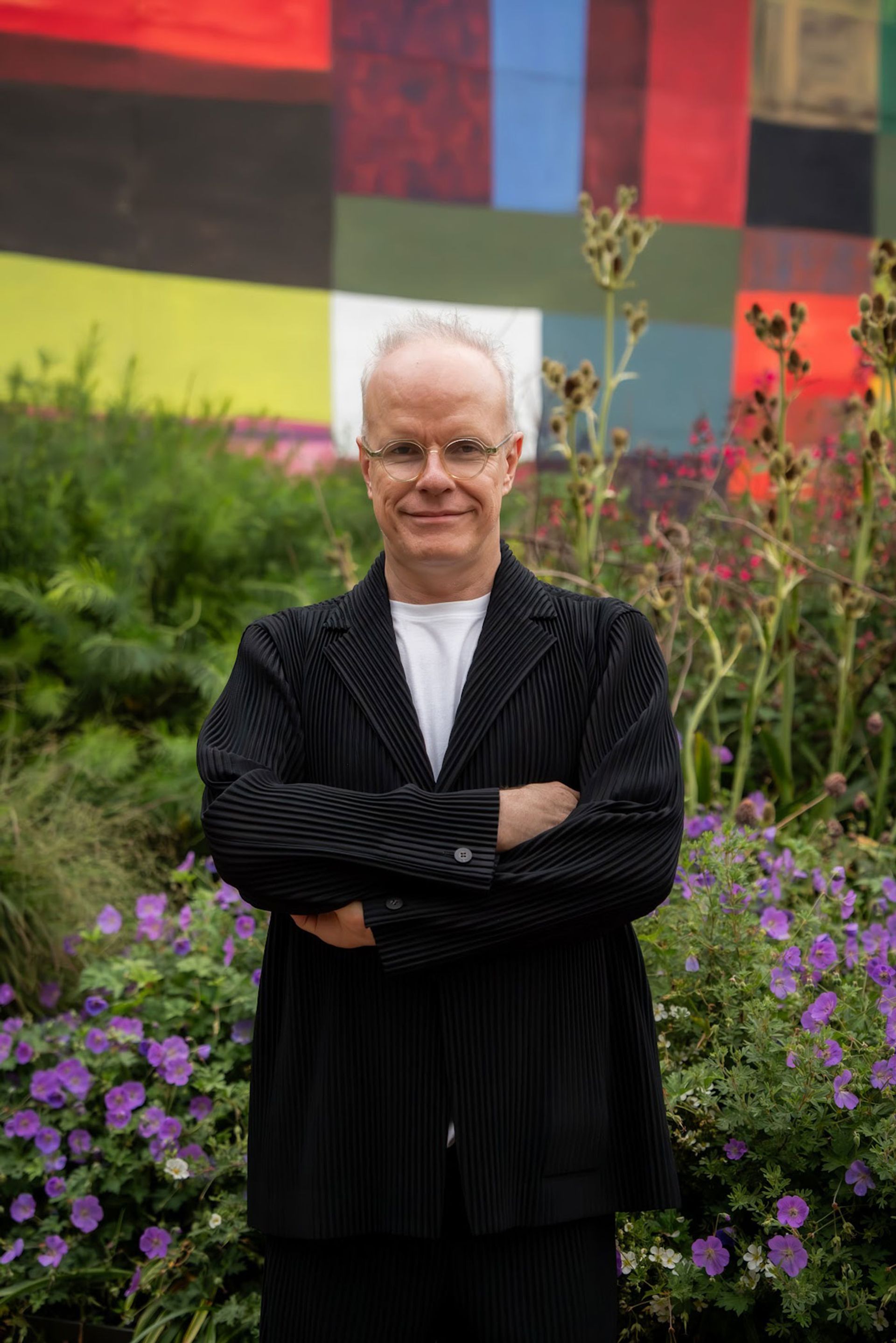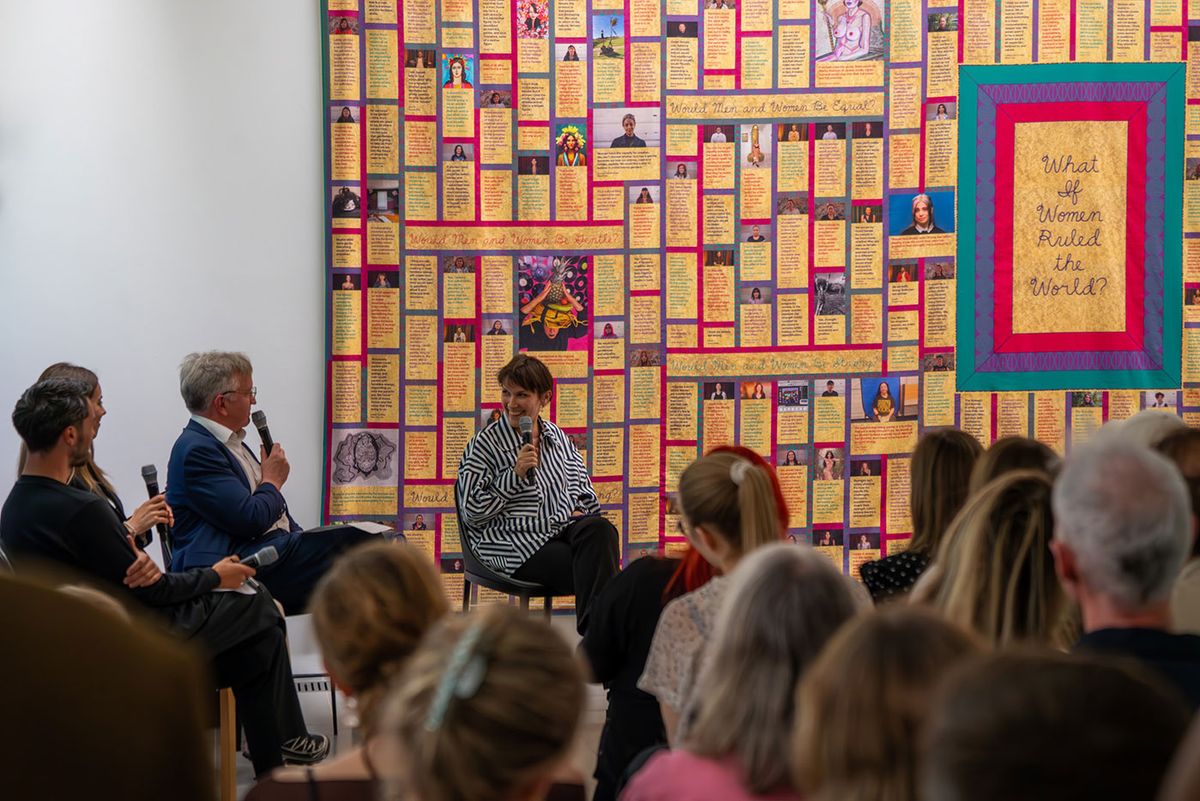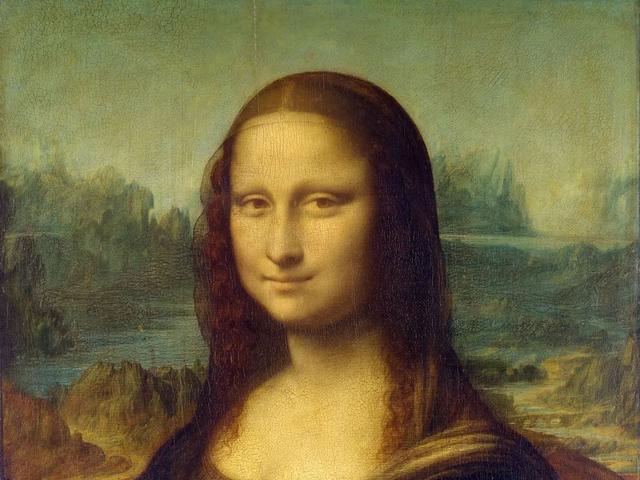Hans Ulrich Obrist, the artistic director of the Serpentine, welcomed the London art world to Serpentine North gallery last night for a private view of Judy Chicago's exhibition Revelations and a panel discussion on the artist's very timely question, “What if Women Ruled the World?”
The panellists for the conversation, chaired by The Art Newspaper's managing editor Louis Jebb, were Chris Bayley, the curator of exhibitions at Serpentine—who oversaw the planning and installation of the eye-opening, graphic-art-rich Revelations—Aleksandra Artamonovskaja, the head of arts at Tezos Ecosystem, and Kay Watson, the head of arts technologies at Serpentine.

Hans Ulrich Obrist, artistic director of Serpentine, introduced the evening © Hannah Goldmsith
The panellists were seated in front of Judy Chicago’s What if Women Ruled the World’ Participatory Quilt, a project created in collaboration with the artist and founding member of Pussy Riot, Nadya Tolokonnikova that seeks to encourage a sharing of ideas about gender equality. The interactive work, produced in partnership with the art and technology facilitators DMINTI, invites visitors to enter the booth at the gallery and watch a short introductory video before responding to one or more of eleven questions by recording a video answer. Afterwards guests at the event, like all members of the public visiting the show, were able to claim a digital participation token registered on the Tezos blockchain.
Obrist addressed the Serpentine's long-standing concern with exploring the connection between art and technology; most recently expressed through Gabriel Massan's computer-game-based work Third World (2023, built in collaboration with Tezos and soon to go on tour in his native country of Brazil); as well as Serpentine's Future Art Ecosystems report Art x AI; Refik Anadol's AI-demystifying exhibition Echoes of the Earth: Living Archive; and, from 4 October at Serpentine North, the artists Holly Herndon and Mat Dryhurst's much anticipated exploration of artificial intelligence via vocal data sets created with community choirs from around the UK.
Nico Smirnoff, the head of communications at Serpentine (and former contributor to The Art Newspaper), oversaw the planning of the evening, which also allowed guests to enjoy a vivid choice of cocktails provided by the evening's fourth partner, X Muse Vodka. These were enjoyed with a view of the gallery’s surrounding Hyde park and the Serpentine lake beyond.
Prominent creative sector figures present at the event included the ever-provocative designer Pam Hogg and Seetal Solanki, author of Why Materials Matter; along with the gallerist Matthew Flowers; Georgina Adam, editor-at-large of The Art Newspaper; the art adviser Teresa Cassidy Krasny; Erica Bolton of the public relations firm Bolton & Quinn; minister Yasuyuki Okazaki from the Japanese embassy in London; and Leyla Fakhr, artistic director of the digital art platform Verse.
Artists in attendance included the portrait and narrative painter Jonathan Parker and, fittingly for a tech-focused evening, two digitally fluent and innovative practitioners: Robert Alice—fresh from his landmark book On NFTs (Taschen, 2024); and his generative art NFT sale with Christie's 3.0—and Gretchen Andrew, author of The Art Newspaper's Art Decoded column.
Also attending were members of the core team from London's National Gallery who have been overseeing the gallery’s 200th anniversary celebrations—Christine Riding, director of collections and research (at present absorbed in a ground-breaking rehang of the gallery), with Tracy Jones, head of communications and Simon Magill, deputy head of communications.

Guests at the panel, private view and party to celebrate Judy Chicago: Revelations at Serpentine North © Hannah Goldsmith
While guests enjoyed the event, some were reminded of one of the works highlighted by Bayley during the panel discussion. In film records of Atmospheres (1968-74), Chicago is shown using pyrotechnics to create coloured clouds that spread out—to soften and transform the surrounding Californian landscape. It was an intervention designed to bring a feminine impulse to a landscape where male landscape artists such as James Turrell had been working to control their environment.
“My colour”, she tells Obrist of those works in an interview for the book Judy Chicago: Revelations (Thames & Hudson, 2024), published to go with the exhibition, “merges with the landscape and mixes with the wind in the air, and the sky”. So Chicago's art and personal inspiration seemed to emerge on a London August evening to mix with the wind, air and sky of Hyde Park.



